
A. Lange & Söhne from 1845 to 1990
With many thanks to Glashütte Watch Museum and Mr. M.
By now, thanks to the brilliant work done by A. Lange & Söhne’s marketing, the books from Reinhard Meis and by the collectors, connoisseurs, journalists, we know a great deal about today’s brand. Even in this humble website, one can find almost all the information that one needs to understand the modern A. Lange & Söhne, what shaped today’s watches and culture of the German manufacture. However, there’s an era that not many people know about, or not even deservedly valued, mentioned by the brand itself. The era between 1845 and 1990.
Indeed, in order to truly understand today’s A. Lange & Söhne, and Glashütte Watchmaking we must look back to the roots. Only then, we can fully appreciate the value of the mechanical art pieces that we have on our wrists.
And it starts with Ferdinand Adolph Lange.
Ferdinand Adolph Lange: 1815 - 1875
Son of Johann Samuel Lange, Ferdinand Adolph Lange was born in 1815. Early in life, his parents were separated, and he was adopted by a foster family. Luckily for him, and for us, his family offered him a chance of proper education and in 1829, he joined the Technical University of Dresden. The studies were demanding, six days of week, divided as three days of theoretical work and three days of manual craftwork, accompanied by a student’s master. Faith, it seems, Lange’s master was none other than Christian Friedrich Gutkaes, maker of the famous 5-minute clock in Dresden Opera House and the court watchmaker later-on.

Gutkaes’ Pocket watch from the 1830s. Courtesy of Dr.Crott Auctioneers
Following 6 years of hard work at school, Lange finished his apprenticeship with honors and went onto work with Gutkaes as his assistant for more than two years. However, Lange’s ambitions were different and to reach out for them, he decided to improve himself even mored. To become a better watchmaker, in 1837, Lange decided to embark on a journey to learn the watchmaking craft from the best of the time – thanks to his language studies in parallel to watchmaking, he was already fluent in French. His journey took him to Paris, Switzerland, and England. He spent four years with the master watchmaker Winnerl (a student of Breguet himself) in Paris and became the foreman. There he filled out his famous notebook with calculations, ratios to apply to his own work, if ever.
Very happy with Lange’s work, Winnerl offered him to stay longer and work with him. However, he had different plans. Ferdinand Lange refused the offer to stay. Because a letter written by Gutkaes prior to his journey was calling him back, saying “don’t forget your home, don’t forget your people”.Lange returned to Dresden in 1841 and took over his now father in-law Gutkaes’ business in 1842. It is within this period where Ferdinand Lange revealed his lifelong ambition: It was to bring prosperity to the once rich, now unfortunate Erzgebirge region, in other words, Glashütte… He wanted to build a watchmaking industry, to offer jobs and improve on what he learnt throughout his journey.

Ferdinand Adolph Lange’s notebook with gear ratio and ligne to metric system calculations
To take on such an endeavor however, he needed funding. Therefore, he wrote a letter to the high council of Saxony, presenting a detailed business plan. A part showing his intention is quoted below:
“…Should the high council be able and willing to grand the wherewithal for the establishment of an institiuton and the welfare of 10-15 young people, and to entrust me with its leadership, I am certain that in a near future, livelihood and prosperity will spread among many these unfortunate people…”
Following lenghty discussions with the council, On December 7th, 1845, Ferdinand Adolph Lange founded A. Lange & Cie. As promised, he started with 15 young-men. His employees were obliged to work with him for 5 years at least, and following, Lange encouraged his apprentices to create their own specialized firms, much like in Switzerland. Lange, not only set motion to a factory, but a watchmaking cluster in the region along with his colleagues Julius Assmann, Adolf Schneider and Moritz Grosmann. In time, there was a specialist for every part, producing individual pieces at highest quality.

Four founding fathers of Glashütte Watch Industry. Seen at Glashütte Watch Museum
Watchmaking in Glashütte
As the article progresses, we are going to see sensational watches from both A. Lange & Cie and A. Lange & Söhne. Moreover, we are going to witness Ferdinand Adolph Lange’s ingenious mind with the numerous mechanisms he developed; from the remontoir to dead-seconds, repeaters and his introduction of metric system to the watchmaking. However, as you might’ve guess, it did not happen over a night. The mature Glashütte Watchmaking that we see on the headlines took almost 20 years to develop and I think it is imperative to witness this evolution to understand different periods, and the region’s development.
As documented by connioseurs and fantastically by the Glashütte Watch Museum, it is possible to talk about 6 phases of development for the modern Glashütte Pocket Watch.
The first pocket watches of the brand were even often missing the brand from the dial and was featuring only basic decoration on the back. Far from what we know as a Glashütte pocket watch. However, you can still get some hints.
Phase I
According to the Glashütte Watch Museum, for the first three years, Ferdinand Lange and Adolf Schneider focused on the training of the pupils. It was only by the year 1848, the first 17 pocket watches were ready for sale.
The characteristics of the first pocket watches can be inferred from the pocket watch No.106. A large triangular top plate covers the gear train as well as the pallet fork. The bridge the escapement is circular, and the barrel bridge takes the form of a steel plate with rounded edges.

Phase II
Most of the changes in this era, again, can be found on the movement. For the first time we see a separate plate instead of a monobloc construction. The separate cock holds the escapement wheel and pallet fork while the balance cock gives us hints for the future.
The dial side of the watches of this era are often simple. Most of the time, one cannot even see the brand name. Serial numbers of the era range from 121 to 830 between the years 1850 and 1853. The example below belongs to Glashütte Watch Museum.
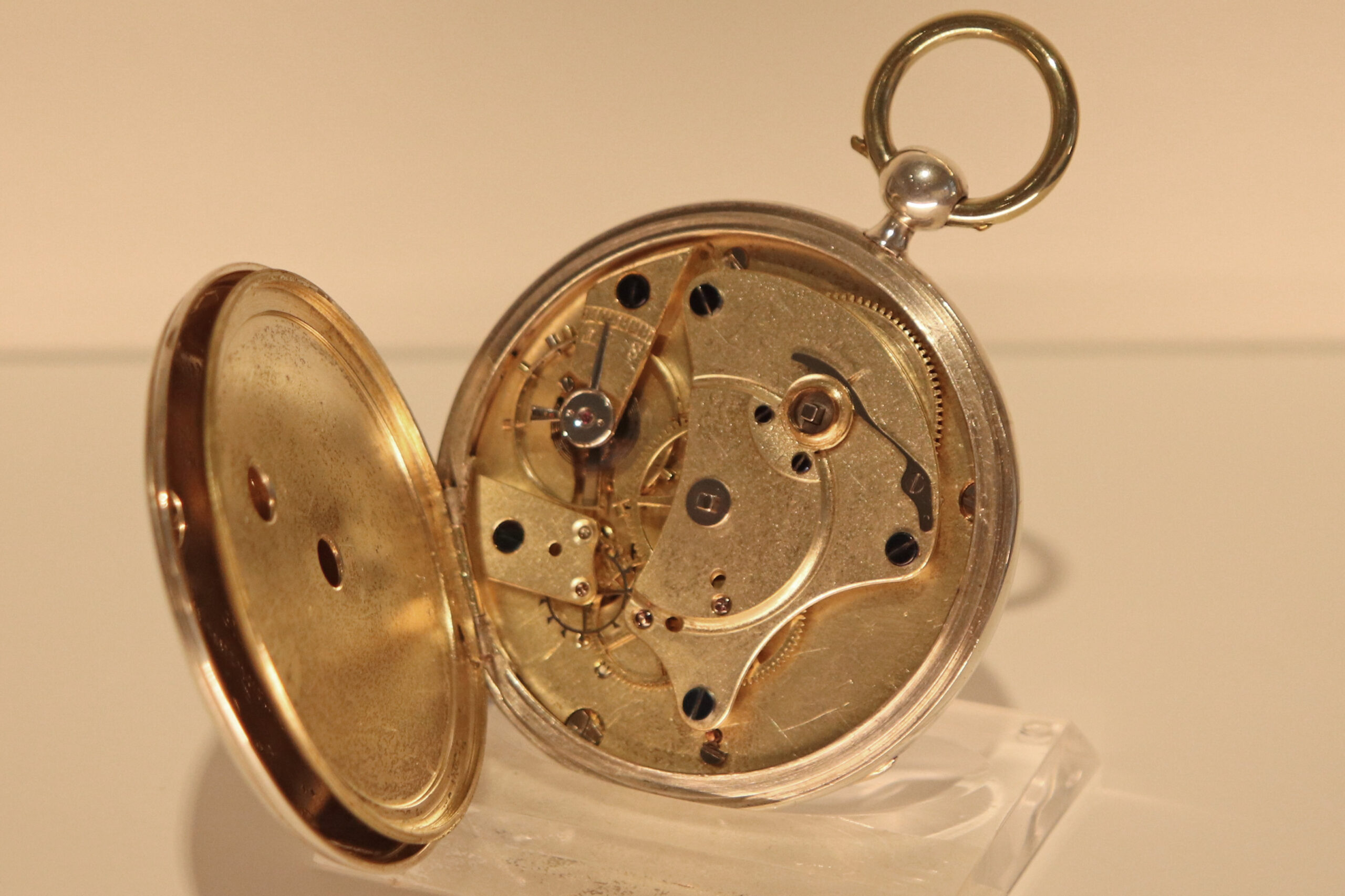
Phase III
The top plate starts its transformation from a triangular shape to a more circular, holistic cover as we see in the modern pieces. The escape wheel and the pallet fork still sit on a separate bridge. With this phase, we see that the manufactures started to adopt brass-steel as a material for the pallet fork. Finally, we have the first pocket watches with crown winding system.
The serial numbers of the era range from 831 to 1290 between the years 1853 and 1855. The example below is from GWM.

Phase IV
In this phase, with the arrival of the half-plate, we finally start to see an evolution towards the defining three-quarter plate. The steel bridge for the barrel is gone, which was replaced by a more rounded brass bridge. Both the escape wheel and the pallet fork now reside under their own bridges and were given their final form. Also, for the first time, we start to see the famous engravings on the balance cock.
It can also be said that the watches show inspiration from British pieces.

Phase V
Half plate transforms towards the two-third plate. The golden pallet fork and escape wheel acquire their final forms. In this period, the crown-winding watches are produced in considerably higher numbers than their key-operated counterparts.
The fine example below is from Moritz Grossmann. Along with Ferdinand Lange, he was one of the key figures of the region. His manufacture, lives once again today, was focusing on all aspects of watchmaking from cases, hands to dials…

Phase VI
It took almost 20 years and around 1860s, what we can call a mature work started to surface. Yes, Glashütte sunburst pattern on barrels, diamond end-stone, gold chatons, blued screws, Glashütte lever escapement with concealed pallets and of course the three-quarter plate – at times with sunburst, at times just plain. This style would stay as virtually unchanged for the following 80 years and would be revived in the 1990s by modern watchmakers. This element is still the most tangible connection to today’s A. Lange & Söhne.
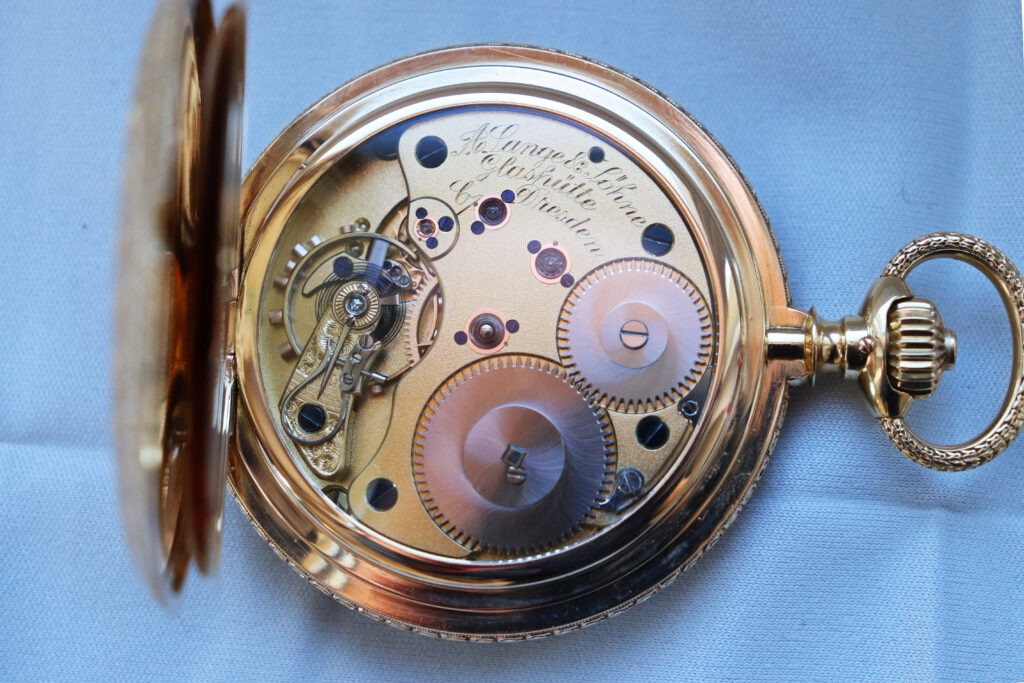
The idea behind the three-quarter plate is to remove the individual bridges to create a more stable movement where all parts are held by one big plate. Below is Ferdinand Adolph Lange’s patent registration for the plate in 1875.

Along with the developing watchmaking and the subsequent production in Glashütte, Ferdinand Lange was also busy with precision mechanics. Indeed, as pointed out by glashuetteuhren.de, “the meticulous, theoretical preparation on a scientific basis was one of the essential keys to Ferdinand Adolph Lange’s later sustainable success.
Already in the Dresden years 1842-1845 as master of the Dresden watchmaking and partner of the company of his father-in-law Gutkäs, Gutkäs & Lange, Ferdinand Adolf Lange manufactured a series of high-quality precision watches, including about five precision dispensers with a special ball inhibition developed by him and 9 kg mercury second pendulum.”
His technical acumen guided him throughout his career, and he registered many patents, from escapement designs to repeaters, to remontoirs and dead-beat seconds,… So much, in 1876, Richard Lange published a paper documenting his father’s inventions.
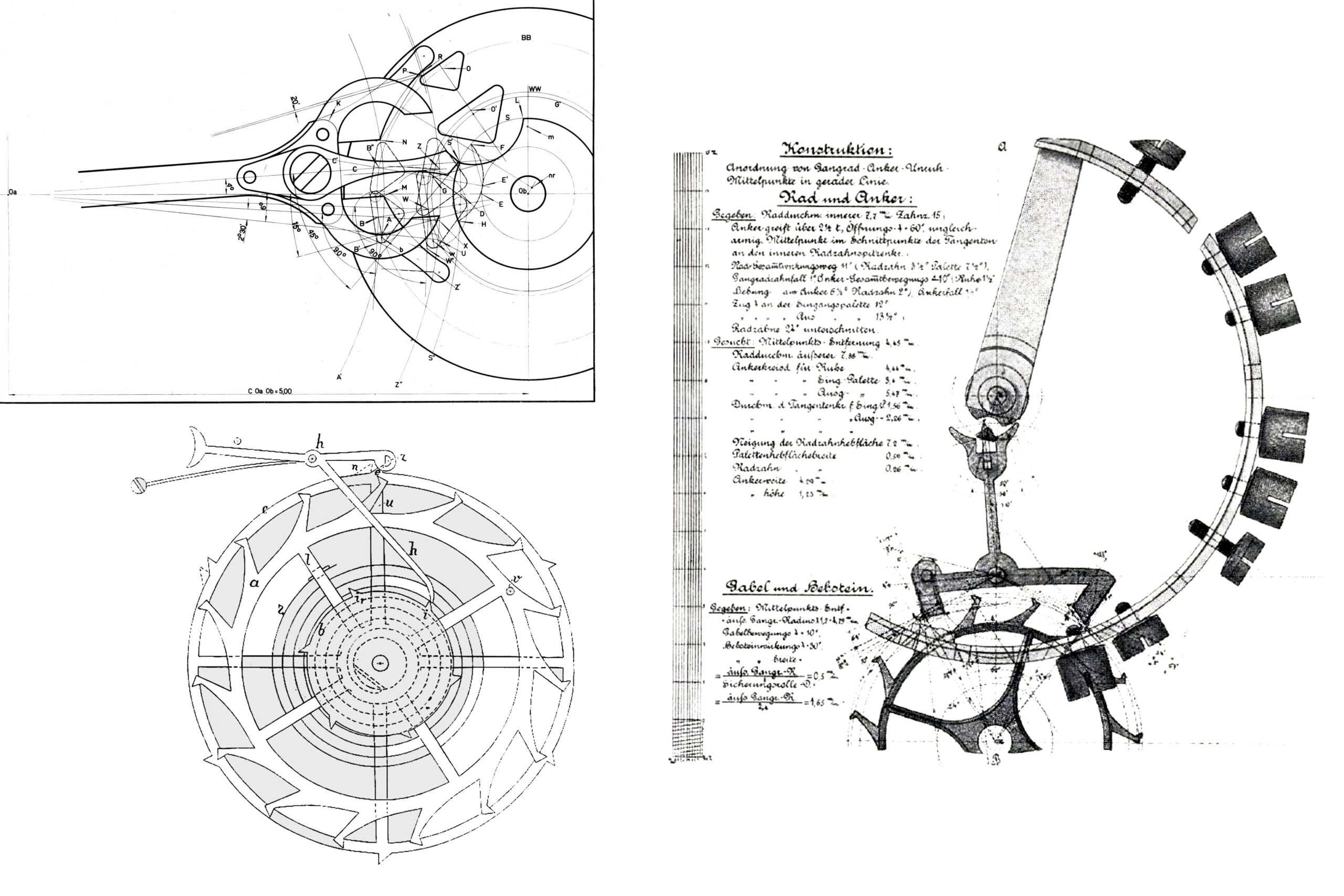
A fraction of Ferdinand Adolph Lange’s patents
For the technical minds, the difference of Glashütte escapement can be summarized as follows, via Gutenberg.org “To obviate this difficulty some fine watches, notably those of A. Lange & Sons, have convex lifting planes on the engaging and concave on the disengaging pallets to reduce friction; the lifting planes on the teeth are also curved.”
In 1868, following successful two decades, and as the mayor of Glashütte, Ferdinand Adolph Lange retired to focus more on the social matters. He enjoyed the fruits of his hard labor within the spacious house built adjacent to the manufacturé, which today serves as the HQ of modern A. Lange & Söhne. The Saxon state immortalized Ferdinand Adolph Lange with a statue in 1895. He gave the reigns of his legacy to his sons Richard and Emil Lange – subsequently the company’s name was changed from A. Lange & Cie to A. Lange & Söhne.
A. Lange & Söhne: 1868 - 1900s
Under the management of both talents, A. Lange & Söhne expanded tremendously. Emil Lange was dealing with management, whereas Richard Lange was responsible for the technical part. In this era, we started to see exceptionally complicated pieces from the brand, which received many international awards. But also, more serially produced clocks for the military. In order to grasp this period as easily digestible and detailed as possible, I’d like to continue both chronologically, but also talk about individuals, such as Richard Lange himself.

Richard Lange’s own quarter-repeater pocket watch. Seen at Glashütte Watch Museum.
Richard Lange is the first-born son of Ferdinand Adolph Lange. The Sr. took him on as an apprentice to himself, instructing him thoroughly in all branches of watchmaking for four years. Funny that is, following his apprenticeship with his father, Richard Lange also took on a journey abroad, and started to work in the atelier of Visiére, a student of Winnerl!
Following his inclusion to the brand, we see that A. Lange & Söhne registered numerous patents, with the focus being on the timekeeping aspect such as regulation, escapements… He improved upon the carousel mechanism, invented by Danen B. Bonniksen and on his patent, A. Lange & Söhne built only 37 pocket watches (source: Dr.Crott Auctioneers) with the said mechanism. However, his biggest invention is without a doubt was the addition of the beryllium to the balance spring alloys, which led the way to the famous Nivarox balance springs. His technical accomplishments inspired the modern A. Lange & Söhne to craft a family of watches to honor his name with a focus on timekeeping and legibility above all, where you can find more information: Richard Lange collection.

Some patents of Richard Lange, karussell (left) and chronometer escapement
Apart from his technical accomplishments, Richard Lange served as the chairman of the Glashütte Watchmaking School for over a decade until his retirement in 1910. It was during his tenure that the school got its electricity and heating system in place. The school published an obituary to Richard Lange, honoring his well-deserved retirement and thanking him for his services both to the region’s itself, and its watchmaking. “Glashütte lost one of its intellectual focal points.”
In 1873, A. Lange & Söhne set up a larger factory in Glashütte and the production ramped up considerably. Just to give you a measure, the manufacture was crafting 500-600 watches per year before the duo took over and the new building. By 1892, A. Lange & Söhne celebrated its 30,000th pocket watch, of course not all were at 1A (highest) quality.
Again, in 1873, Ferdinand Adolph Lange put together a reference system to define what does an 1A quality pocket watch from A. Lange & söhne mean:
- Three quarter plate
- Sunburst on the barrels
- Engraved balance cock with diamond end-stone
- Screwed gold chatons
- Glashütte Anchor Escapement
- Balance spring with double Philipp’s overcoil (with exceptions)
- Balance wheel with golden screws
- Nickel-steel balance (only after 1907, with exceptions)
Though the watches were at magnificent quality, there was a problem; A. Lange & Söhne’s domestic market was weak. In one report, the company states the following: “Due to the price of our watches, we have to look to abroad to source our sales”. To combat, in 1877, we see the introduction of “DUF” watches “Deutsche Uhren Fabrikation”. According to glashuetteuhren.de, the watch wholesaler Dürrstein & Co had acquired the sole distribution right for A. Lange & Söhne watches for the entire country. As the long-time partners of the brand, Dürrstein was trying to convince A. Lange & Söhne to produce a pocket watch with lower-quality, hence lower price to increase its range and sales. In 1877, following two years of Ferdinand Adolph Lange’s passing, the DUF watches were officially introduced.

According to an excerpt from Allgemeiens Journal der Uhrmacherkunst, A. Lange & Söhne further continues “It should be mentioned that the manufacture of the secondary quality watches in our company is by no means new, but has been in practice since the beginning, as it is not possible to manufacture all parts with perfection. It would not make economic sense to put aside these parts as completely worthless, which although functional and theoretically well executed, do not have the degree of perfection in themselves that we use for watches of the highest quality (referring to the 1A quality pocket watches)”.
A. Lange & Söhne made “DUF” pocket watches starting with the serial number of 20001. Some differences between the DUF and 1A quality pieces are:
- 14k gold housing instead of 18k
- Balance spring in steel & brass instead of nickel
- Rubies set directly on the plate instead of the use of gold chatons
- Movement plate is gold plated brass instead of nickel silver
- Movement engravings feature “DUF” or “DUF and A. Lange & Söhne” together instead of A. Lange & Söhne alone

Please note the missing blued screws, hand-engraved balance cock, and gold chatons.
In 1877, we also see one very important patent by Richard Lange. Already in 1867, Ferdinand Adolph Lange devised an independent jumping seconds mechanism “seconde morte” with stop feature but not zero-reset. His son improved upon the invention and patented in 1877.
The reason for Richard Lange’s development’s importance is that it was revived in 2017 with the Homage to Walter Lange special edition.
As a man with strong family values, it is known that Walter Lange has been asking A. Lange & Söhne to revive the invention of his great-grandfather for years. Alas, possibly due to sales projections, the brand never ventured into developing such a mechanism – until Walter Lange’s passing. Mr. Lange passed in January 2017. To honor his legacy, the product development department came up with a modern interpretation of the patent received in 1887. You can read the in-depth story at Homage to Walter Lange article.

Come to 1880, we see another very important patent registration that also has found its place in the modern A. Lange & Söhne catalogue. The Up/Down (power reserve indication) mechanism.You can read about this signature complication in-depth via the article: 1815 Up/Down.
From the 1880s to 1900s, under the helm of Emil Lange, A. Lange & Söhne significantly increased its popularity and received countless awards both in terms of timekeeping and aesthetics, from international and local authorities alike. Within this era, we start to see more and more complicated pieces, marine chronometers, but also exceptionally crafted cases with engraving and enameling techniques.
These elaborate watches are the proof that A. Lange & Söhne started to have a worldwide recognition and the clientele to accompany. Indeed, as sources point out, some pieces sell at a range that is even more expensive than their Swiss counterparts.
The work done in this era is just outstanding. Aurel Bacs, Senior Consultant of Phillips in Association with Bacs & Russo, states when you handle a Lange pocket watch, just like today, the feeling of heft, the quality is just unparalleled. A. Lange & Söhne was a brilliant watch manufacture back then, and so is today.

An A. Lange & Söhne Pocket Watch with Graff engraving
A. Lange & Söhne’s relation with the military kicked-off with the marine chronometer production within this period, too. For the Reich, the fleet, therefore the marine chronometers were essential. A great watchmaker, Fridolin Stübner was the head of the production and in 1896, we see the first two A. Lange & Söhne marine chronometers. Following the successful measurements undertaken by the Deutsche Seewarte Hamburg, the marine chronometers, observatory pieces were purchased by the Reich Naval Office. Following, A. Lange & Söhne expanded the manufacture with an extra building just to produce marine chronometers. By 1920, the brand delivered 384 marine chronometers to the observatory for test reasons, later to be sold to the army. (Source: glashuetteuhren.de) The topic with the Third Reich is going to be examined in the section A. Lange & Söhne and Military separately.
In the year 1900, for the first time, A. Lange & Söhne publicly introduced a tourbillon pocket watch at the Paris Exhibition, where Emil Lange himself was part of the jury. The watch was named as Jahrhunderttourbillon (the tourbillon of the century) and was made in the honor of the exhibition, depicting Paris before Minerva on the caseback.
The tourbillon cage was made by none other than Fridolin Stübner, with a heavy inspiration from Switzerland. Even the thought of achieving something this precise and detailed only with hands and pen & paper is just remarkable and the pocket watch Nr. 41000 is a testament of the capabilities of both Stübner, and A. Lange & Söhne at the time.
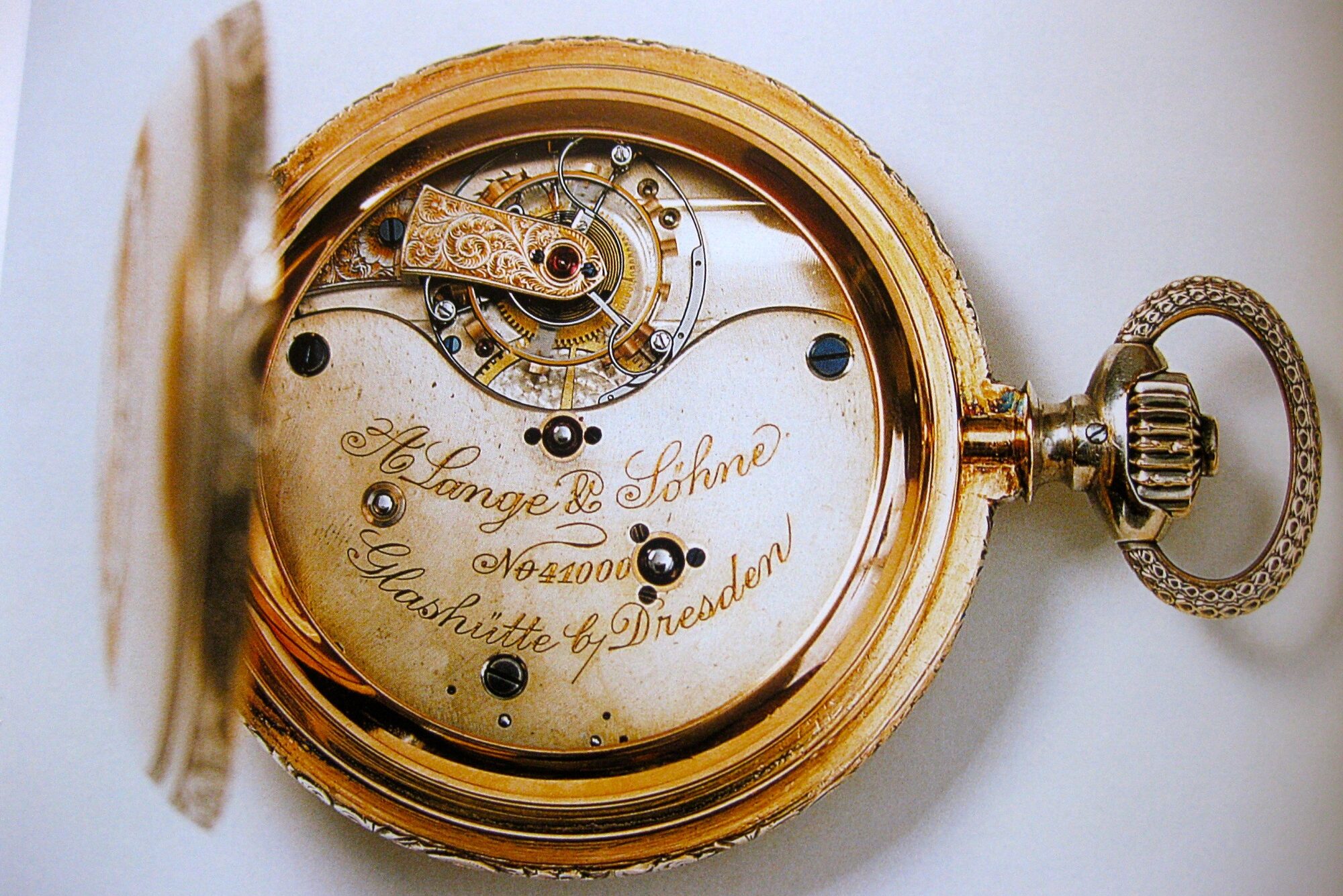
A. Lange & Söhne Tourbillon pocket watch Nr.41000. Courtesy of langeaficionado
Please also note that throughout its almost 100 years of existence, the brand crafted only 12 pocket watches with tourbillon escapement, making each one of them extremely valuable. Another very important piece made in this era is the famous Grand Complication, number 42500, sold to Vienna for 5,600 Marks in 1902.
We can summarize the 19th century as A. Lange & Söhne’s foundation, technical development and growing period. The brand was doing brilliant both on the military and civilian front and was on the path to become a worldwide phenomenon. However, the 20th century would not be as fruitful.
A. Lange & Söhne - 20th Century
The 20th century arrived with a storm of change to Glashütte. Glashütte Precision Watch Manufacture Akt. was founded in 1904 and followed by “Nomos” in 1908. Both companies were producing machine-made watches or movements imported from Switzerland and cased up in Glashütte. By contrast, A. Lange & Söhne and few others were still crafting hand-made watches, utilizing dated manufacturing techniques; therefore, operating with high costs. What’s more, the triumph of wristwatches was approaching, but Lange had no investment or plans at all to join the unstoppable trend.
A catalogue from 1911 showcases what kind of pieces A. Lange & Söhne was producing at the time, and I’d like to give a few examples before going into the consolidation era of the brand.

Utterly complicated pieces in the middle (of the catalogue), and exceptional engravings on the right. A note here, in 1874, A. Lange & Söhne introduced a ladies’ model at 25 mm, one of the smallest of its time. Since then, the ladies’ watches never left the catalogue. The piece below houses the rattrapante and minute repeater (mechanism on the dial side) complications and is from 1901. Just look at the gorgeous work on the filing, polishing, and movement construction. Just astonishing work.

Another fantastic movement type from the era is the self-winding mechanism. In its 100 years of existance, A. Lange & Söhne produced about 40 pieces with the said system. Though in modern times, the brand came up with the ingenious Sax-0-Mat (Saxonia – Langematik article) movement in 1997, it always baffled me why they haven’t thought of adopting the hammer system. As you might know, Moritz Grossmann was the one who came up with the Hamatic which is surely one of the finest pieces one can get from Glashütte.
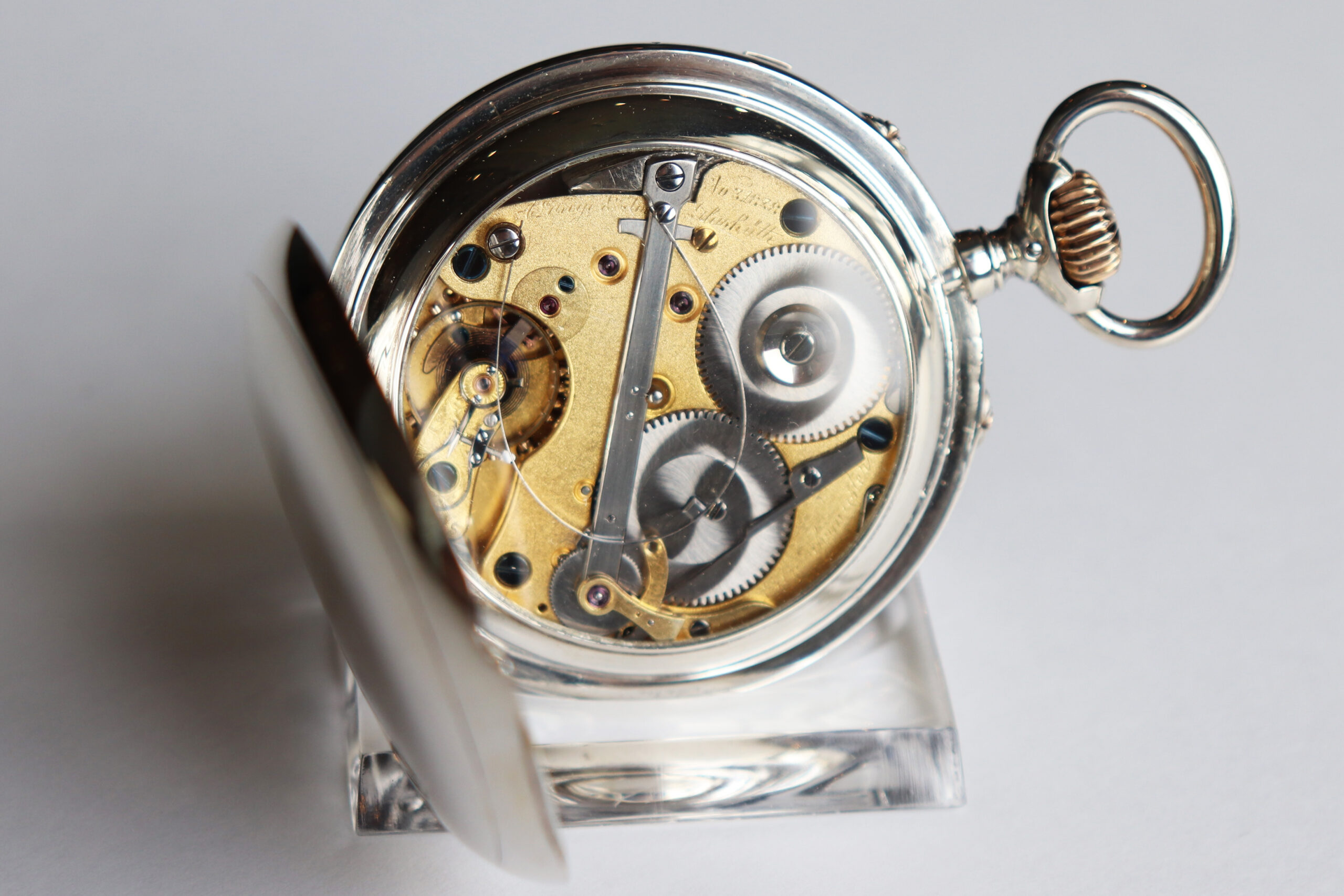
Engraving has always been one of the strongest suits and defining characteristics of A. Lange & Söhne. Just like the handwriting, every engraver has a style based on a general pattern, and thanks to this individuality, every A. Lange & Söhne timepiece is blessed to be unique. Today, we see this art taken to the extreme levels with the Handwerkskunst collection. It is also fun to see such executions in the pocket watch era too. The example below is from ca. 1910. With a stunningly engraved dial, engraved and enameled case.
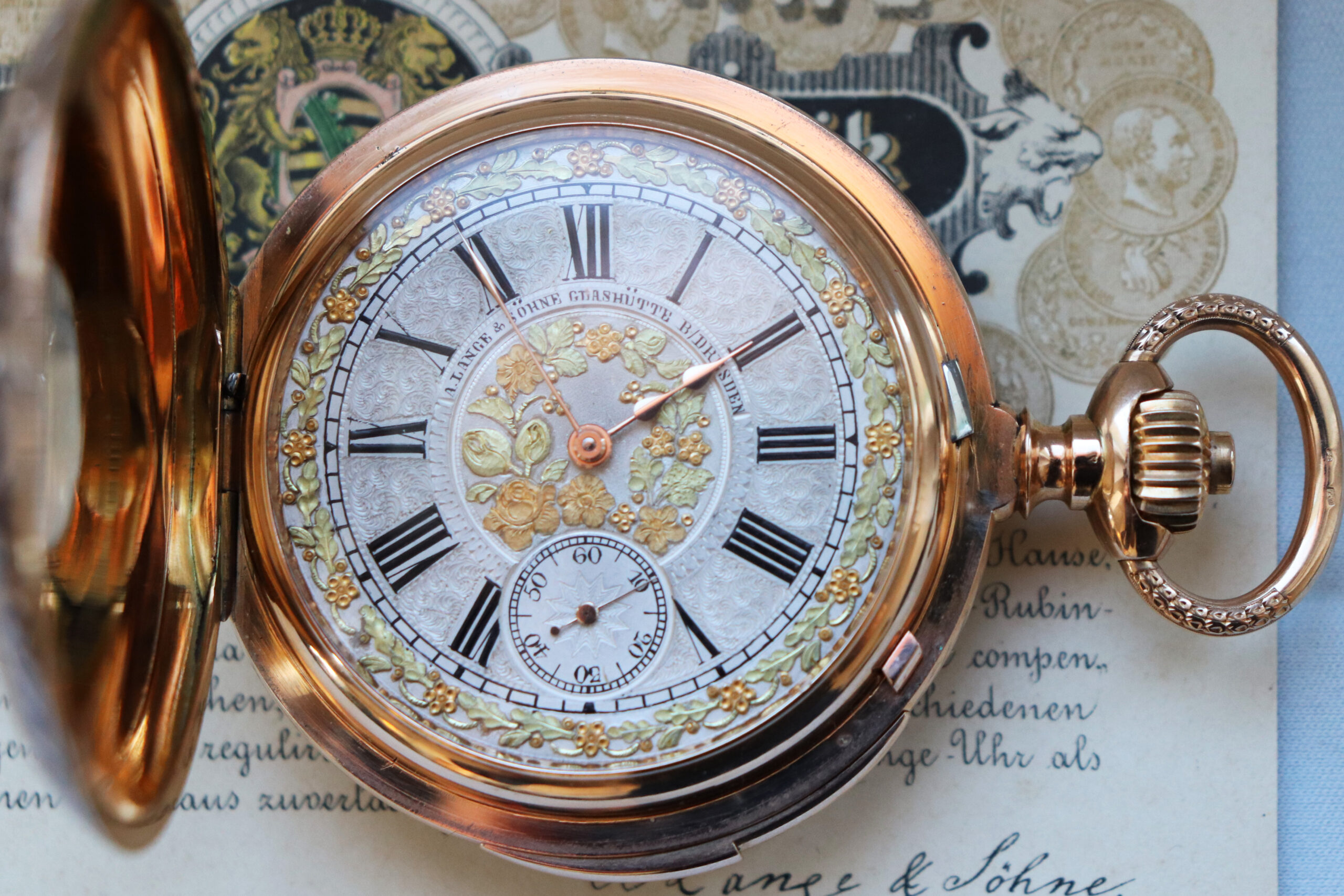
The Fall Begins
As mentioned, A. Lange & Söhne started to feel the effects of the changing landscape with the first decade of the 20th century. An asymmetric competition was brewing from Glashütte. On the other hand, Germany was one of the main actors of the World War I, and war comes with its price. The hyperinflation was causing corporate bankruptcies, leaving many people unemployed, and impossible to sell high quality watches, basically anywhere in the world, let alone Germany.
By July 1923, the Reichsbank had lost control of the economy. Notgeld (emergency Money printed by authorized institutions in order to cope with the physical Money shortage because the central bank couldn’t issue enough) flooded the economy, being issued by any city, town, business, or club that had access to a printing press, in order to meet the insatiable rise in prices. Even Serienscheine were being hand-stamped with large denominations to meet the demand. By September, Notgeld was denominated in the tens of millions; by October, in billions; by November, trillions. (Wikipedia)
A. Lange & Söhne was one of those institutions. The journey started with a few hundred marks, ended up as 500 billion Marks.
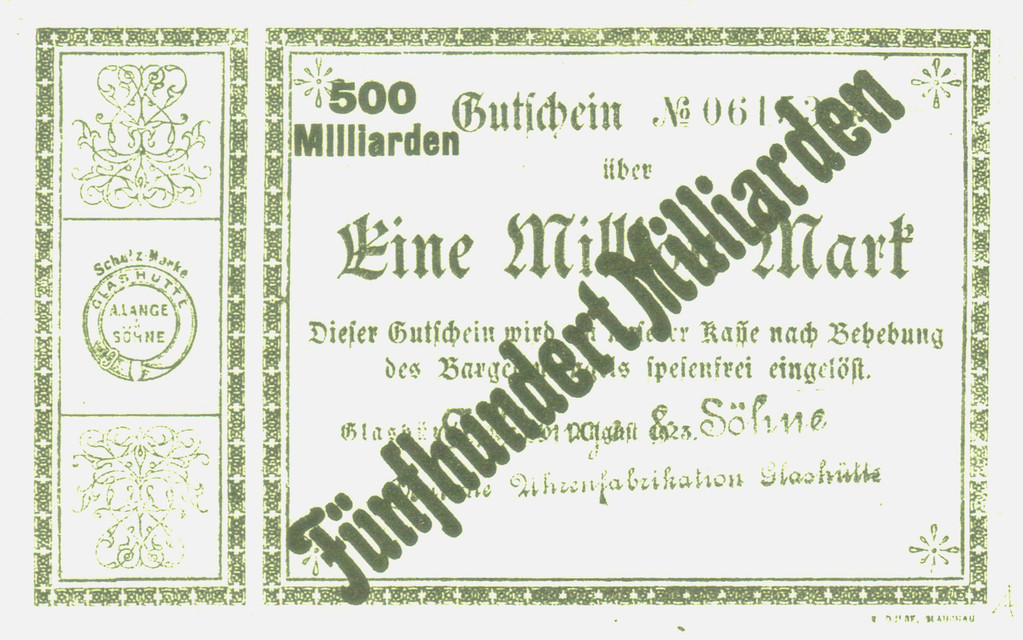
On economic collapse Walter Lange would say:
“I was born in the Weimar era; then came the crash in 1929 and the great unemployment (90% to some sources). I can still see it today; it was a childhood trauma for me, when I looked out the living room window and saw all the unemployed men lined up, waiting across the street. I will never forget that view.” (Source, Walter Lange biography)
A. Lange & Söhne took its chances to adapt to the changing world. As a response to two trends, i.e., automatization & low cost, and wristwatches; we see that the brand took necessary actions, albeit considerably late. The answer to the former was a new subsidiary brand called OLIW – Original Lange Industry Werk. A simpler form of A. Lange & Söhne watch, with more easily applicable standards, and a re-arranged caliber suitable for faster workflow. OLIW was introduced in 1925.
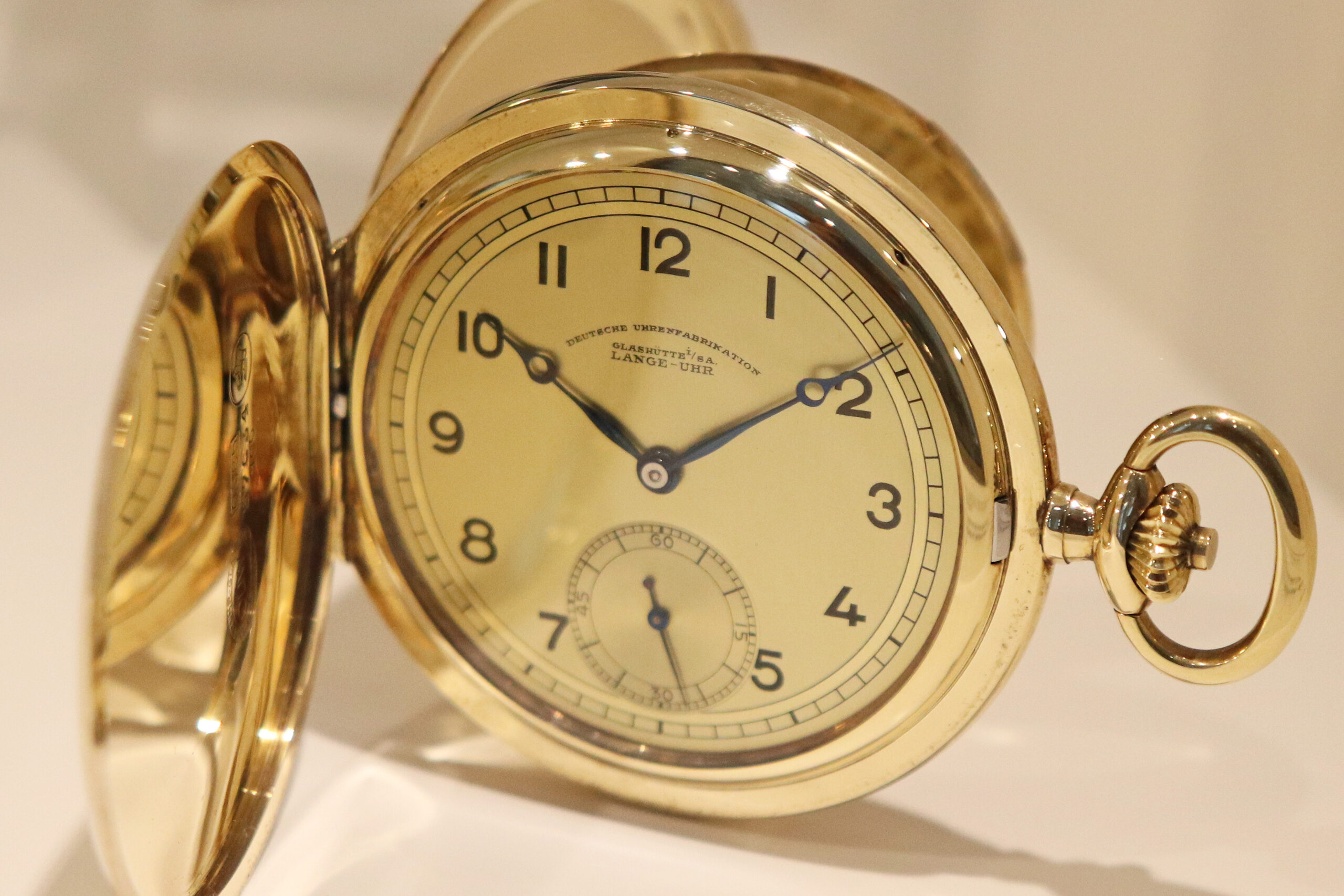
An A. Lange & Söhne “OLIW” pocket watch. Seen at Glashütte Watch Museum.
Few points were considered for the OLIW watches to remove costs:
- Easily serviceable
- Parts interchangeable
- Easily disintegrable (made of bridges instead of the plate for easy disassembly)
- Silver and even steel could be used
Alas, the intended success did not arrive. It took years for the company to set-up the procedure (the brand was introduced in 1925, the first product came out in 1928) and it cost a fortune to A. Lange & Söhne, however, the scale just was not there.
Following the disappointing sales with OLIW, A. Lange & Söhne mainly focused on military equipments such as marine chronometers or pilot’s watches for the rest of the ’30s. The manufacture, once making pocket watches for the kings, queens, was nothing but an industrial shadow of its own.
A. Lange & Söhne's First Wristwatches
The wristwatch attempt on the other hand is a bit more interesting. As mentioned, during the 1920s, the sales of pocket watches saw a steep decline. Some companies adjusted this well, but the problem for A. Lange & Söhne was that the company never produced a wristwatch movement before. Indeed, there was a ladies’ pocket watch movement, alas, it was too expensive to craft in the first place.
For this, the brand went for the easy way out – that is, sourcing movements, decorating them, stamping the brand on top, and selling as A. Lange & Söhne. We know that years before Lange committed to this path, the brand sued several manufactures in Glashütte for applying the exact same practice. To benefit from the know-how in Switzerland, A. Lange & Söhne opened a branch in Geneva in 1927.
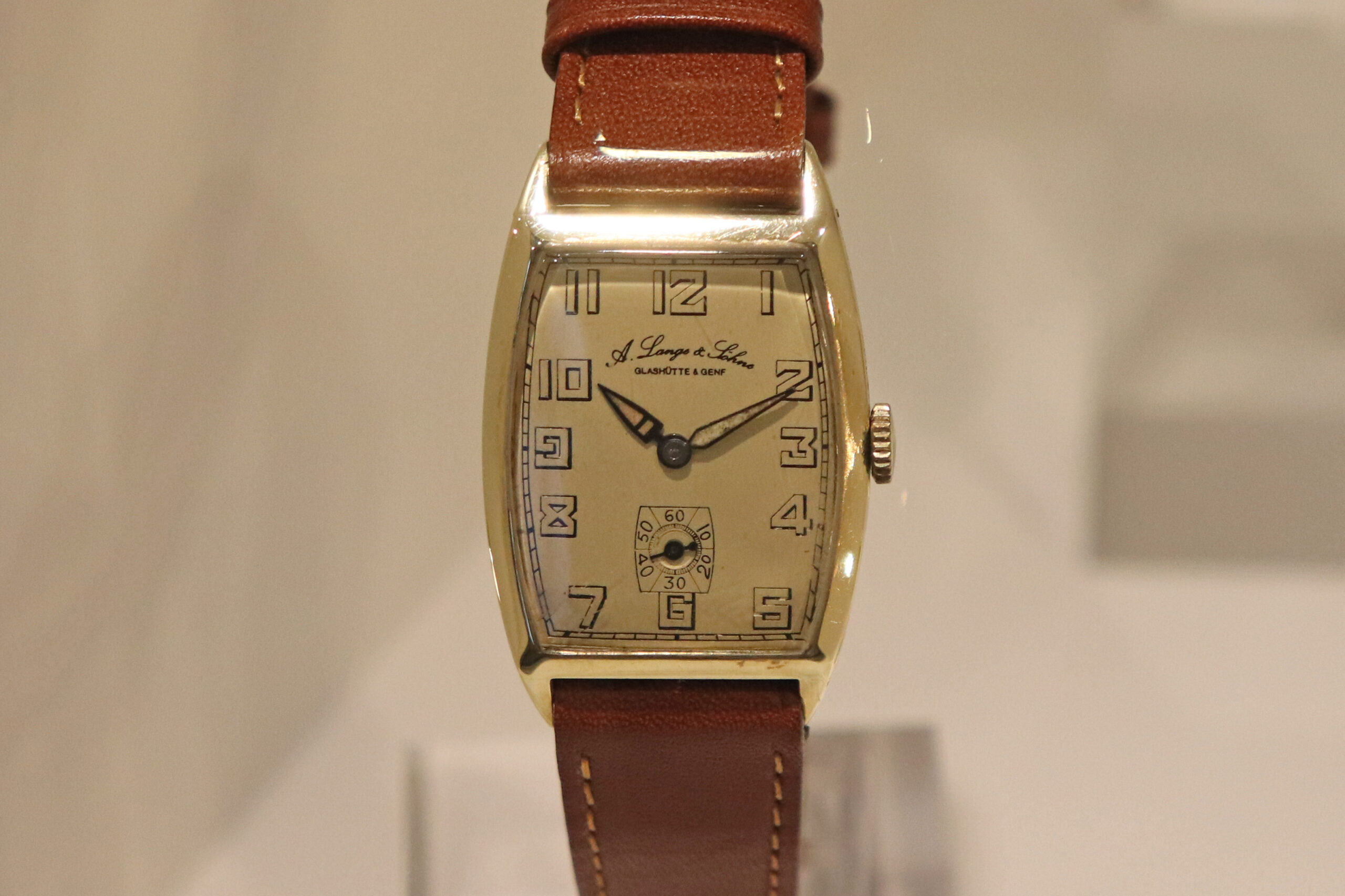
A. Lange & Söhne Genf wristwatch. Seen at Glashütte Watch Museum
For the first tonneau shaped wristwatches, A. Lange & Söhne utilized Niton, Altus, UROFA movements with a size of 11 lignes. This very same movement (Niton) was also present in various Patek Philippe, Chopard, Gübelin wristwatches. (Source, Klassik uhren Nr. 2/2013 – Wolfgang Stegemann) Such heritage can also be the inspiration for a modern classic, A. Lange & Söhne Cabaret.

Various early Lange wristwatches and outsourced movements. Courtesy of glashuetteuhren.de
From the 1920s to the company’s fall in the 1950s, A. Lange & Söhne bought ebauches, cases from Switzerland and Glashütte, finished in its own ateliers and sold under different names Lange Uhr, Lange Glashütte I/SA, A. Lange & Söhne Geneva.
The dials both for the OLIW pocket watches and A. Lange & Söhne “Genf” wristwatches were supplied from the Pforzheim based Weber & Baral.
Speaking of Weber & Baral, and the 1930s, we must look at the Bauhaus Movement, and its profound impact on the watch designs.
Often, we hear, especially from the brands like Nomos, Stowa, Laco, etc. about the Bauhaus inspired dial design. Even if we look back at the ‘90s, we see that A. Lange & Söhne also incorporates the Bauhaus design principles in the marketing materials. So, where do all these come from?
Quote Wikipedia: Bauhaus was a German art school operational from 1919 to 1933 that combined fine arts and crafts. The school became famous for its approach to design, which attempted to unify the principles of mass production with individual artistic vision and strove to combine aesthetics with everyday function.
In a nutshell, the Bauhaus movement is about finding the simplistic and aesthetically conscious solution for a purpose. No frills, no extra. Less is more says Mies Van der Rohe, former director of the Bauhaus Architecture School.
Despite its short life, the Bauhaus movement left a permanent impact in many areas of design. Indeed, we celebrated its 100th Anniversary just in 2019, a testament to its importance. We can see the movement’s effects on a variety of areas via its alumni from architecture to painting to typewriters to furniture… and of course, watches.

To begin with, Christopher Waluga, the founder of nomoswatchclub.com and an alumni Bauhaus University in Weimar directly states “The bitter truth is that neither a wristwatch, nor a pocket watch or wall clock, have left the famous classrooms and workshops of the Bauhaus between the years 1929-33”
Further, Mr. Waluga explains principles of the Bauhaus style as follows:
- Form follows function
- Less is more
- Typography matters
- Gesamtkunstwerk (complete form of art that is the synthesis of multiple forms of art)
- Affordability and Mass-Productibility
In 1937, we see the first A. Lange & Söhne wristwatch dials inspired from the Bauhaus design philosophy, coming from the mentioned Weber & Baral. According to Stowa, A. Lange & Söhne was the client Nr.1 for the dial design.

To read more on the fascinating topic of Bauhaus design & Watchmaking, I’d highly recommend also to check on the Junghans’ Max Bill pieces and the modern Nomos, which are arguably the two most prominent representatives of the language.
A. Lange & Söhne & Military
Another area of interest by many collectors, which unfortunately was never enlightened or discussed by the modern A. Lange & Söhne is the brand’s relationship with the military and the regime at the time.
The start of the relationship between the Nazi party and Glashütte dates to the mid 1930s. According to Klassikuhren 6/2005, Glashütte Watchmaking School under the tutelage of Alfred Helwig presented the Hitler Tourbillon DUS No.27. An excellently made flying tourbillon pocket watch, just like all of Mr. Helwig’s pieces, yielding excellent results at the test done by Deutsche Seewarte Hamburg, which was one of the observatory bodies at the time. The construction of this watch was started well before the seize-of-power (Machtergreifung) by the Nazis.

An article published in the Deutsche Uhrmacherzeitung (via uhrenpaul.eu) in 1939 reads the following from Mr. Helwig: In the spring of 1934, a naval observation watch was presented to our Führer Adolf Hitler as an expression of boundless trust so he knows that all sections of the people were behind him…. (Among many more presents) this watch meant more: It proved that German precision watch manufactures were ready and able to do their part in building a new army and a fleet. I hoped to be able to assimilate National Socialist ideas more directly…
In 1933, Glashütte was visited by Nazi Party representatives for the exhibition in the Glashütte Watchmaking School and few other manufactures, including A. Lange & Söhne. As mentioned above, the brand already had extensive experience in marine chronometer production for military purposes (under Bismarck era), and from 1933 to 1939, it was the only brand to submit Marine Chronometers from Glashütte to Hamburg Observatory. (Source: Kaliber 100 Marine Chronometer) for military purposes to be utilized in Kriegsmarine.

The famous Kaliber 48 was also developed and produced within this period. The development started in 1937, based on the existing OLIW movement, but the production only in 1940. Because the military required only 1 second deviation a day and the existing movement was not at the needed quality. We see that the Kaliber 48 was utilized in pocket watches with Up/Down and small seconds indication and a very few pieces with additional central seconds.
According to the brilliant article written by Waldemar Becker in KlassikUhren in 1998, from 25th October 1940 to 8th May 1945, 5975 clocks with caliber 48 were delivered. Due to the capacity problems, the production was spread through several manufactures such as Andreas Huber, Wempe, Alpina-Dugena, etc..
It is within this period we see the A. Lange & Söhne pocket watches which Hitler presented to his army officials mostly as Christmas presents. Most of these orders were (except for a couple) placed through Adolf Lünser, owner of Lünser retailer in Berlin. According to the exceptional research done by Waldemar Becker and Christian Pfeiffer-Belli which was published at Klassikuhren in 2005, Hitler gifted 10 pocket watches with special engravings to his closest circle, all bearing the brand A. Lange & Söhne. The gifts showcase a mixture of quality levels, be it 1A, 1B or 1C. The article also notes there were also a few complicated pocket watches.
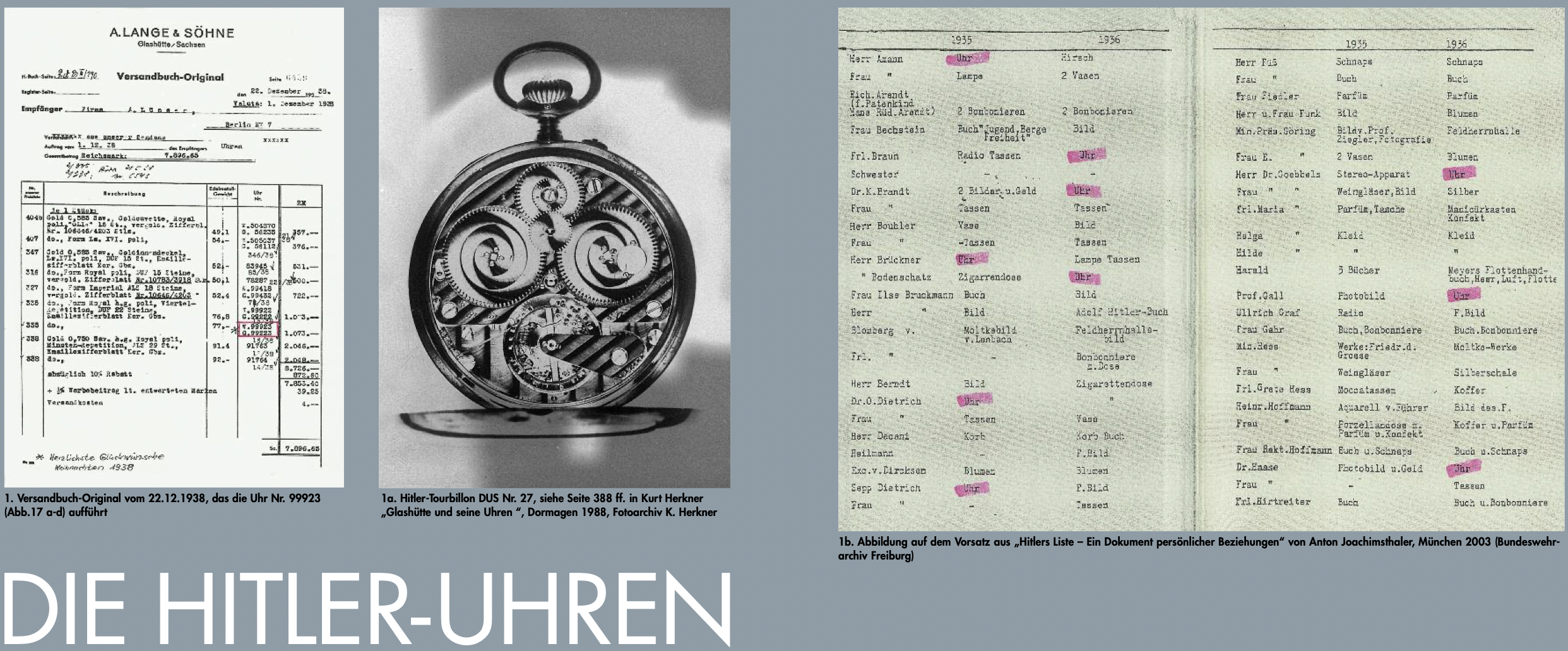
Source, klassikuhren 2005, written by the legend Christian Pfeiffer-Belli
Among the military production, during the late 1930s, A. Lange & Söhne was still producing civilian watches, even a tourbillon or two. However, the army was experiencing supply shortages from Glashütte. The production by Lange and Urofa were simply not enough. A Reich order came in 1941 and put an end to the civilian watch production as we know it. All civilian watch production and even the development was prohibited. Glashütte was transformed full on machine for the army.
According to the documents published by glashuetteuhren.de article From 1900 to 1949; unfortunately, the orders were not the only measures to ramp up production. As with almost all other industrial companies of Germany, such as Krupp, Siemens, Porsche, VolksWagen and many others, the forced labor was a thing in Glashütte watch industry, which A. Lange & Söhne was also a part of.
Here, I must say I have seen no further documents besides the ones published by the author at the mentioned source above, which strongly builds itself on the official papers as well as the letters from the captives. I wish that Glashütte Watch Industry would face such documents head on as many other corporations did, and we would have the chance to understand the whole.
A. Lange & Söhne B-UHR
Hitler’s seizure of power was a long period (1931-1933) full of political games, negotiations, riots and many deaths. After years of trying, he was finally the chancellor of Germany on 30 January 1933. On the 27th ofJanuary 1933, four weeks after the election, the Reichstagsbrand (Reichstag Fire, arson of the Parliament Building) took place.
Following the event, Hitler asked for emergency powers to combat with Communists, and only within days, most of the opposition party’s people were arrested and disbanded. With the election done on 5th March, with the absence of the opposition, Nazis secured the majority in the parliament (despite 45% vote).
On the 23rd of March 1933, Hitler got the Ermächtigungsgesetz (Emergency Act) that gave him the power to impose laws without parliament’s consent and started his dictatorship.
As you can see, the dates coincide with when Nazis seize the power, visit Glashütte, and the start of the production for the observatoire pieces. It was all part of the re-armament period, as Nazis always used civilian cover ups for military training. It was glider clubs for training pilots, or sporting clubs for training Nazi SA militias.
In 1935, Hitler came out on rejecting the Treaty of Versailles, freeing Germany’s military arm and the Lutfwaffe (German air force) was re-activated in February. When war declared, the Lutfwaffe would play a crucial role for the Blitzkrieg doctrine and for that to happen, the German army needed pilot’s watches, thus born the famous B-UHR. A. Lange & Söhne was among the 5 manufactures who produced B-Uhr pieces, the others being Laco, Stowa, Wempe and IWC.

The information below is an excerpt from Waldemar Becker’s Article on KlassikUhren 4/98
The B-Uhr deliveries started around the same time with the clocks. Lange’s B-Uhr pilot’s, navigator’s watches utilized the caliber 48, but omitted the Up/Down indication from the dial as the legibility was the primary objective. The caliber reference number was 48/1. According to the article, the sale of the Flieger watches was started with the case number 210131 in 1940 and ended with 216978 in 1945. The watches feature a hacking-seconds mechanism for the pilots and the navigators to synchronize the time.
The cases were made of stainless steel and covered with gray lacquer for protection. Flieger B-Uhrs were measuring at a 55 mm due to the pocket watch movement and needed legibility. On the case band, one can see the factory and the requirement number. Inside, the manufacturer, device no (127-560A-1) and the completion company (as with clocks, the Flieger-Uhrs were completed at several other plants due to capacity problems).
One note: From 1944, in order to avoid targeted enemy bombings, the manufacture names were no longer engraved under the caseback. Instead, every manufacture used a code name. A. Lange & Söhne’s was “nhk”.
Apart from the usual 55 mm versions, A. Lange & Söhne also produced 65 mm versions for a couple of years for the Waffen SS.

One of 22. Source: Hermann Historica Auctions
The inverted number versions like the one above is called Sextant Watch. A. Lange & Söhne produced 22 of these pieces, and they were highly valued even back then. The officer who used the watch had to return it to his/her superior after the completion of duty. The striking mirror writing indication of the sextant watch was necessary so that the watch could be used together with the visor device of a mirror sextant. (Source: uhrendirect.de) From 1949 to 1967, under the Soviet reign, the caliber 48/1 was also in production, long after the destruction of Glashütte and A. Lange & Söhne. The article points out that the case number of these watches are between 217391 and 218270. Apart from these pieces, there are also B-Uhr’s from the brand which the employees made for themselves utilizing the caliber 48/1. The best way to authorize your B-Uhr watch is to ask Glashütte Watch Museum for a Certificate as the Museum retains all the sales records.
Obliteration of Glashütte
On 7th May 1945, the last day of the World War II, the Soviets entered the Müglitz Valley. The SS troops were still forming a defense line over Glashütte. Knowing this, Soviets bombarded the city on the 8th. A. Lange & Söhne’s manufacture was one of the buildings that got hit. Walter Lange, 21 years old at the time witnessed the obliteration of his family’s legacy.
Following the unconditional surrender of the German Reich on the 8th, the Allied forces immediately started the reorganization of the German economy. In July 1945, the Soviets dismantled all essential parts of watchmaking in Glashütte. The industry was brought to a complete standstill for a couple of years.
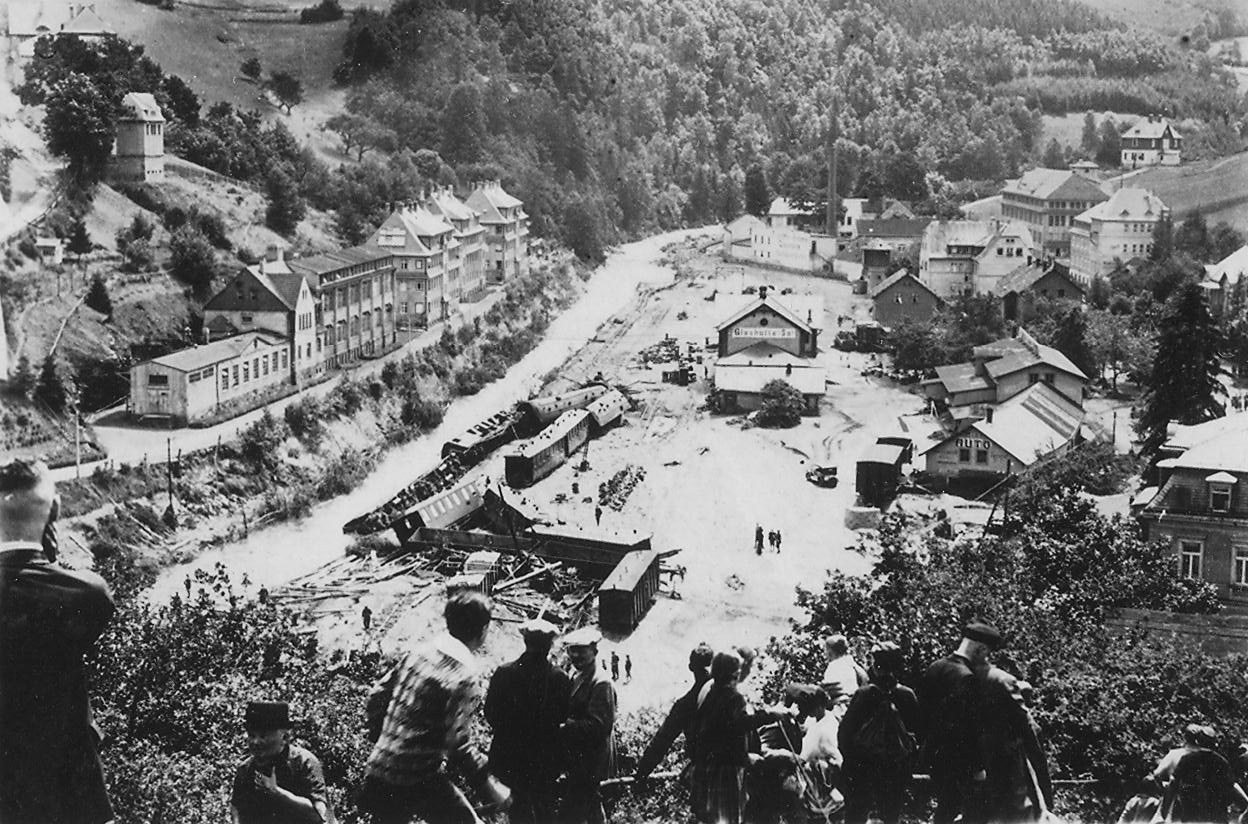
Destruction of Glashütte. Müglitz river to the left.
However, even the bombing and the severe injury did not stop Walter Lange (21 years old) and he actively tried to revive his family’s name on watches once again. He knew that the future was in wristwatches, which A. Lange & Söhne did not adapt in the past. Unfortunately, while working on this new wristwatch, faith showed his bitter side once again: Glashütte fell under the control of the Soviet Union in the post-war Germany. Dictated by the communist regime, private ownership was a thing of the past, and A. Lange & Söhne was nationalized in 1948, renamed as Lange VEB Glashütte. A. Lange & Söhne completed a wristwatch movement, based on the pocket watch kaliber 48, in 1948, which was named as kaliber 28. These watches, however, were branded as Lange VEB Glashütte and not A. Lange & Söhne and have nothing to do with the family.


In 1951, only after 3 years of Lange-VEB, all the manufactures of Glashütte were nationalized and merged under the name GUB. The merged manufacture continued the production of Kaliber 48, 100 and 28/1 for some more time. Private ownership was a thing of the past and the names did not matter anymore. Walter Lange was forced to work at the Bizmut Uranium Mines, a slow and sure death… He fled to Western Germany, to the Black Forest region Pforzheim, and there, he tried one more time.
In his book When Time Came Home, he mentions the following: So we started with a very family watch production: We bought boxes with parts from Deutsche Uhren-Rohwerke for a hundred clocks each, which my wife and I then reassembled at the kitchen table after work. The clocks were sold under the name ALP, which means A. Lange Pforzheim, a funny coincidence that is also my name! He continues “Later we expanded the business and concentrated only on the clock reassembly. My brother (Ferdinand Lange) ran the business, I ran the workshop with up to seven watchmakers.”

However, following the declining sales and different paths, Walter Lange left the company, and worked for Wellendorff, which was going to be an important contact when A. Lange & Söhne re-born in the 1990s. From the 70s till the 90s, the name Lange was gone completely, and perhaps for all eternity. Luckily, a gentleman named Günter Blümlein had different plans.
Re-birth
Even though the high-end watch industry in Glashütte was ceased to exist, it was still remembered by connoiseurs like Reinhard Reichel (former director of the Glashütte Watch Museum), Helmut Crott, Martin Huber, and of course Günter Blümlein. A true visionary who was known as the man who saved IWC and Jaeger-LeCoultre, Blümlein was looking for opportunities to expand LMH’s portfolio. The talks began to materialize when the Berlin Wall fell in 1989 and there was only one name that would fit Blümlein’s vision for the peak of watchmaking – A. Lange & Söhne.
Blümlein’s first thought was to create a joint venture with GUB manufacture which was the cluster of nationalized watch manufactures of Glashütte. However, upon a travel to Glashütte, he saw that such initiative was impossible. GUB was simply too big and obsolete, employing 2000 people, producing tens of thousands of watches per year. Following, Blümlein decided to revive A. Lange & Söhne from scratch.

In January 1990, after two months of the fall of the wall and Blümlein’s visit to Glashütte, Walter Lange and his wife Jutta were enjoying retirement at the age of 66. Their phone was ringing. Walter Lange picked it up and on the other end, there was Günter Blümlein offering the unbelievable: to fulfill Walter Lange’s dream to rebuild his family business. Ich war total erstaunt says Walter Lange, I was totally stunned. Nonetheless he took no time to think on the next steps. After in-depth talks, strategy creation, Walter Lange re-registered the name Lange Uhren GmbH on December 7th 1990, exactly 145 years after his great grandfather.
Thank you.
Albeit very extensive, this article doesn’t claim to be complete. If you have further information, or anything you’d like to add or substract, please kindly email to alp@langepedia.com.
Below, please find a few must-read sources to cover this period, or go even deeper.
- Glashütte Watch Museum
- Glashuetteuhren.de – Glashütte between 1900/1949
- German & British Military Timepieces (Vol I & II) Konrad Knirim
- Reinhard Meis – Das Tourbillon
- Reinhard Meis – Great Timepieces of Saxony
- KlassikUhren Magazine
- Martin Huber – Die Uhren von A. Lange & Söhne
- Researches of Konrad Knirim
Please feel free to contact:
Follow Langepedia on Instagram:
Watch “A. Lange Story” Documentary, in partnership with WatchBox:
STAY IN TOUCH
Sign up for the newsletter to get to know first about rare pieces at Marketplace and in-depth articles added to the encyclopedia, for you to make the most informed choice, and first access!